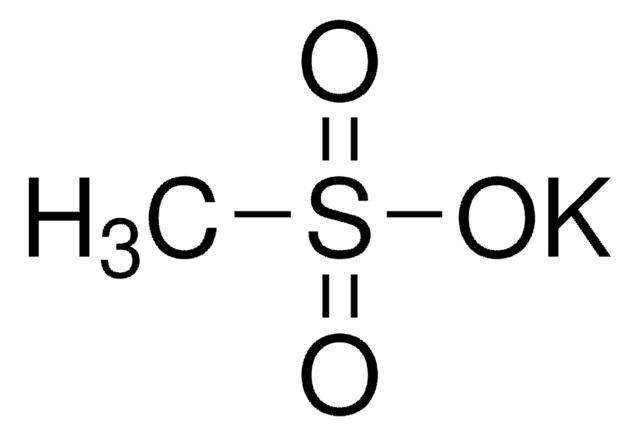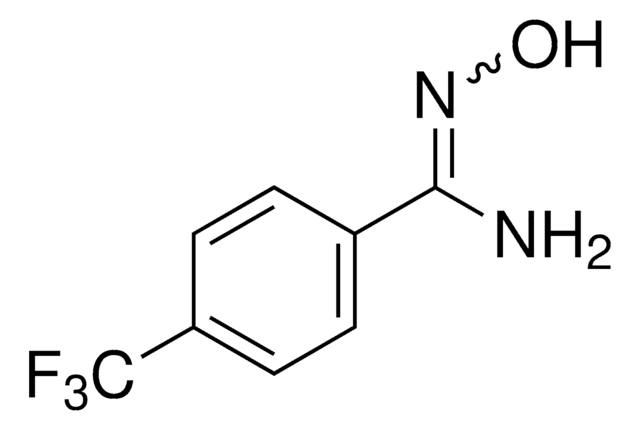Wszystkie zdjęcia(3)
Kluczowe dokumenty
P8131
Potassium hexacyanoferrate(III)
ReagentPlus®, ~99%
Synonim(y):
Potassium ferricyanide, Red prussiate
Zaloguj sięWyświetlanie cen organizacyjnych i kontraktowych
About This Item
Wzór liniowy:
K3Fe(CN)6
Numer CAS:
Masa cząsteczkowa:
329.24
Numer WE:
Numer MDL:
Kod UNSPSC:
12352302
Identyfikator substancji w PubChem:
NACRES:
NA.21
Polecane produkty
klasa czystości
reagent
linia produktu
ReagentPlus®
Próba
~99%
Formularz
powder or crystals
pH
6-9 (25 °C, 329 g/L)
ciąg SMILES
[K+].[K+].[K+].N#C[Fe-3](C#N)(C#N)(C#N)(C#N)C#N
InChI
1S/6CN.Fe.3K/c6*1-2;;;;/q;;;;;;-3;3*+1
Klucz InChI
MIMJFNVDBPUTPB-UHFFFAOYSA-N
Szukasz podobnych produktów? Odwiedź Przewodnik dotyczący porównywania produktów
Powiązane kategorie
Opis ogólny
Potassium hexacyanoferrate(III) can be used as a one-electron oxidant for the oxidation of quinolines, thiamines, and cyclic amines.
Zastosowanie
- Enzymatyczna synteza aktywnego składnika skóry - glochidonu przez dehydrogenazę 3-ketosteroidową ze Sterolibacterium denitrificans: Podkreślenie wykorzystania heksacyjanożelazianu(III) potasu w zastosowaniach biochemicznych, w szczególności w reakcjach enzymatycznych obejmujących procesy konwersji steroidów (Wojtkiewicz AM et al., 2024).
- Puste nanostruktury pochodzące z ZIFs poprzez strategię silnego/słabego koetonowania dla akumulatorów Zn-Air o długiej żywotności: Demonstruje rolę heksacyjanożelazianu(III) potasu w tworzeniu nanostrukturalnych materiałów do ulepszonego elektrochemicznego magazynowania energii, istotnych dla technologii akumulatorów (Li S et al., 2024).
- Opracowanie immunosensora elektrochemicznej spektroskopii impedancyjnej do monitorowania insuliny z wykorzystaniem chinonu pirolochinoliny jako połykalnej sondy redoks: Incorporates Potassium hexacyanoferrate(III) for developing advanced biosensors with applications in healthcare diagnostics (Khanwalker M et al., 2024).
- Selektywna ekstrakcja złota z odpadów elektronicznych przy użyciu odczynników syntetyzowanych w wysokiej temperaturze: W badaniu wykorzystano heksacyjanożelazian(III) potasu w nowatorskich metodach odzyskiwania metali szlachetnych z odpadów elektronicznych, oferując zrównoważone podejście do gospodarki odpadami i recyklingu (Li J et al., 2024).
- Regulowana entropia elektrochemiczna poprzez porządkowanie rozpuszczalników przez supramolekularnego gospodarza: Bada chemiczną wszechstronność heksacyjanożelazianu(III) potasu w tworzeniu responsywnych środowisk molekularnych dla systemów energetycznych, podkreślając jego znaczenie w materiałoznawstwie i badaniach termodynamicznych (Xia KT et al., 2023).
Informacje prawne
ReagentPlus is a registered trademark of Merck KGaA, Darmstadt, Germany
Ta strona może zawierać tekst przetłumaczony maszynowo.
Hasło ostrzegawcze
Warning
Zwroty wskazujące rodzaj zagrożenia
Zwroty wskazujące środki ostrożności
Klasyfikacja zagrożeń
Aquatic Chronic 2 - Eye Irrit. 2
Zagrożenia dodatkowe
Kod klasy składowania
13 - Non Combustible Solids
Klasa zagrożenia wodnego (WGK)
WGK 2
Temperatura zapłonu (°F)
Not applicable
Temperatura zapłonu (°C)
Not applicable
Wybierz jedną z najnowszych wersji:
Masz już ten produkt?
Dokumenty związane z niedawno zakupionymi produktami zostały zamieszczone w Bibliotece dokumentów.
Klienci oglądali również te produkty
Simultaneous detection of thiamine and its phosphate esters from microalgae by HPLC
Pinto E, et al.
Biochemical and Biophysical Research Communications, 291, 344-348 (2002)
Osmium (VIII)-catalyzed oxidation of some cyclic amines by potassium hexacyanoferrate (III) in alkaline media: A kinetics and mechanistic study
Al-Subu M, et al.
Chemistry of Heterocyclic Compounds, 39, 478-484 (2003)
Behaviour of cooxidation of isopropyl ether of vitamin A with cumene in chlorobenzene
VaRdanyana R, et al.
Oxidation Communications, 36, 845-851 (2013)
Kinetics of Oxidation of Some Fluoroquinolones by Hexacyanoferrate (III) in Alkaline Medium
Diab N, et al.
International journal of chemistry research, 34, 1388-1388 (2013)
Catherine M Czeisler et al.
The Journal of physiology, 597(8), 2225-2251 (2019-02-02)
The embryonic PHOX2B-progenitor domain generates neuronal and glial cells which together are involved in chemosensory control of breathing and sleep homeostasis. Ablating PHOX2B-derived astrocytes significantly contributes to secondary hypoxic respiratory depression as well as abnormalities in sleep homeostasis. PHOX2B-derived astrocyte
Nasz zespół naukowców ma doświadczenie we wszystkich obszarach badań, w tym w naukach przyrodniczych, materiałoznawstwie, syntezie chemicznej, chromatografii, analityce i wielu innych dziedzinach.
Skontaktuj się z zespołem ds. pomocy technicznej





